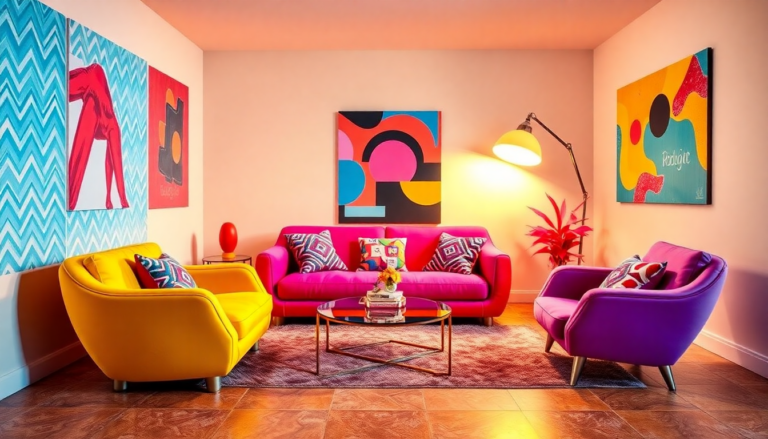Argomenti trattati
Picture this: neon colors, geometric patterns, and a sense of playful excess. For many, the 1980s evoke memories of vibrant shopping malls and synth-heavy tunes that blasted from boomboxes. But beyond the fashion and music, the interior design of this decade has been experiencing a thrilling resurgence. It’s not just nostalgia; it’s a rebellion against the sameness that has saturated modern spaces. Designers and homeowners alike are embracing the maximalism of the ’80s, and it’s breathing new life into our living environments.
Understanding the allure of 1980s maximalism
As we navigate through a whirlwind of social media images that often feel overly curated, many long for spaces that reflect their individuality. Brad Thornton, a designer from Next Wave, notes that there’s a growing demand for homes that don’t resemble cookie-cutter showrooms. “People are tired of the same bland aesthetics,” he says, and that’s where the boldness of 1980s design comes in. This era’s maximalism, highlighted by the Memphis design movement, is all about personality and vibrancy. It invites us to fill our homes with colors and shapes that tell our stories.
Key elements of 1980s interior design
Think of saturated colors, geometric patterns, and furniture that makes a statement. The Memphis Group, known for its whimsical mix of styles and materials, brought a fresh perspective to design. Anne McDonald emphasizes that today’s maximalism isn’t about clutter; it’s about comfort and expression. “It’s not just excess for the sake of excess,” she explains. Today, we can integrate those bold colors and patterns into our spaces in a way that feels cozy and personal, much like wrapping ourselves in a warm, familiar blanket.
Blending old with new
Curved sofas have taken center stage in recent years, a nod to that sculptural furniture trend we’ve seen emerge. Yet, as Thornton points out, while they look fantastic, they may not always be the best for lounging while binge-watching your favorite series. This is where the elegance of Italian postmodernism comes into play. It provides a structure that complements those organic shapes, creating a delightful balance between comfort and style.
The emotional appeal of bold design choices
There’s something inherently comforting about the aesthetics of the ’80s—perhaps it’s the nostalgia that resonates with millennials, who remember it as a time of carefree childhood. Thornton likens it to the “1990s Taco Bell energy,” which might seem silly, but it captures the essence of joy and playfulness that many crave today. As Kevin Sawyers eloquently puts it, “The frivolity of it is attractive in a time of despair.” This era’s designs offer a form of rebellion against the monotonous gray tones that dominate contemporary home decor.
Color combinations that pop
Today, it’s all about reimagining those vibrant color pairings. Gone are the days of merely slapping together bright hues like ketchup and mustard. Instead, we see sophisticated combinations such as burgundy with mint or teal alongside eggplant. These unexpected duos breathe life into modern furnishings and provide a canvas for expression without overwhelming the senses.
The art of pattern mixing
One of the hallmarks of 1980s design is its playful approach to patterns. It’s like a grand symphony of colors and prints, where large florals can share space with geometric motifs. But, as Thornton cautions, this can either be a stunning success or a dismal failure. The key lies in intentionality. By keeping within a single color family or going all-in on one print, you can create a statement that feels fresh rather than dated.
Modern interpretations of 1980s glamour
The glamour of the ’80s is making its way back into our homes, but with a modern twist. Ashi Waliany highlights how today’s applications of rich materials and high-gloss finishes are more subdued than before. We’re moving away from flashy displays and instead opting for pieces that resonate with our personal style. Oversized sofas in luxurious textures like mohair or bouclé, along with sleek marble dining tables, reflect that era’s essence while integrating seamlessly into contemporary decor.
Looking toward the future
As we embrace the vibrant spirit of the 1980s, it’s not just about aesthetics—it’s a reflection of who we are today. In a world where we often feel disconnected, the revival of such expressive design choices allows us to reclaim our individuality. It’s a way to make our homes not just livable, but truly reflective of our personalities and experiences. Personally, I believe that as we continue to navigate through uncertainty, the spaces we create can provide comfort and joy, reminding us of the playful heart of design. So, why not embrace the maximalism of the ’80s? After all, it’s all about celebrating life and the stories we tell through our spaces.
And as many know, home is where the heart—and the vibrant colors—are.

